商务英语教案
商务英语阅读教案
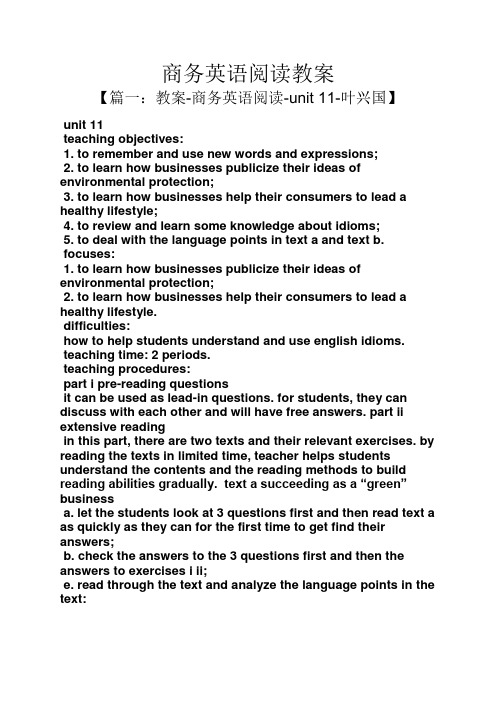
商务英语阅读教案【篇一:教案-商务英语阅读-unit 11-叶兴国】unit 11teaching objectives:1. to remember and use new words and expressions;2. to learn how businesses publicize their ideas of environmental protection;3. to learn how businesses help their consumers to lead a healthy lifestyle;4. to review and learn some knowledge about idioms;5. to deal with the language points in text a and text b.focuses:1. to learn how businesses publicize their ideas of environmental protection;2. to learn how businesses help their consumers to lead a healthy lifestyle.difficulties:how to help students understand and use english idioms.teaching time: 2 periods.teaching procedures:part i pre-reading questionsit can be used as lead-in questions. for students, they can discuss with each other and will have free answers. part ii extensive readingin this part, there are two texts and their relevant exercises. by reading the texts in limited time, teacher helps students understand the contents and the reading methods to build reading abilities gradually. text a succeeding as a “green” businessa. let the students look at 3 questions first and then read text a as quickly as they can for the first time to get find their answers;b. check the answers to the 3 questions first and then the answers to exercises i ii;e. read through the text and analyze the language points in the text:1. increasing numbers of businesses, both small and large, are jumping on the “green bandwagon”. 越来越多的企业,无论规模大小,都正一窝蜂地涌向“绿色浪潮”。
商务英语备课教案模板及范文

一、教案名称商务英语写作课程教案二、教学目标1. 让学生掌握商务英语写作的基本原则和格式。
2. 培养学生撰写商务信函、报告、备忘录等应用文的能力。
3. 提高学生的商务英语沟通能力和专业素养。
三、教学对象商务英语专业本科生或职场商务人士四、教学内容1. 商务英语写作概述2. 商务信函的写作3. 商务报告的写作4. 商务备忘录的写作5. 商务英语写作常见错误及避免五、教学时间8课时六、教学准备1. 教材:《商务英语写作》2. 教学课件3. 商务英语写作范文4. 商务英语写作练习七、教学过程第一课时:商务英语写作概述1. 导入:介绍商务英语写作的重要性及在职场中的应用。
2. 讲解:商务英语写作的基本原则和格式。
3. 举例:分析商务英语写作的范文,让学生了解写作规范。
4. 互动:让学生举例说明商务英语写作在实际工作中的应用场景。
第二课时:商务信函的写作1. 讲解:商务信函的种类、格式及写作技巧。
2. 举例:分析商务信函的范文,让学生掌握写作方法。
3. 练习:让学生根据所学知识,撰写一封商务信函。
第三课时:商务报告的写作1. 讲解:商务报告的种类、格式及写作技巧。
2. 举例:分析商务报告的范文,让学生了解报告写作规范。
3. 练习:让学生根据所学知识,撰写一份商务报告。
第四课时:商务备忘录的写作1. 讲解:商务备忘录的种类、格式及写作技巧。
2. 举例:分析商务备忘录的范文,让学生掌握写作方法。
3. 练习:让学生根据所学知识,撰写一份商务备忘录。
第五课时:商务英语写作常见错误及避免1. 讲解:商务英语写作中常见的错误及避免方法。
2. 举例:分析商务英语写作中的错误,让学生引以为戒。
3. 互动:让学生分享自己在商务英语写作中遇到的问题及解决方法。
第六课时:商务英语写作综合练习1. 练习:让学生结合所学知识,完成一份商务英语写作综合练习。
2. 评讲:教师对学生的练习进行点评,指出优点和不足。
第七课时:课程总结与反馈1. 总结:回顾本课程的主要内容和重点。
商务英语阅读教案lesson
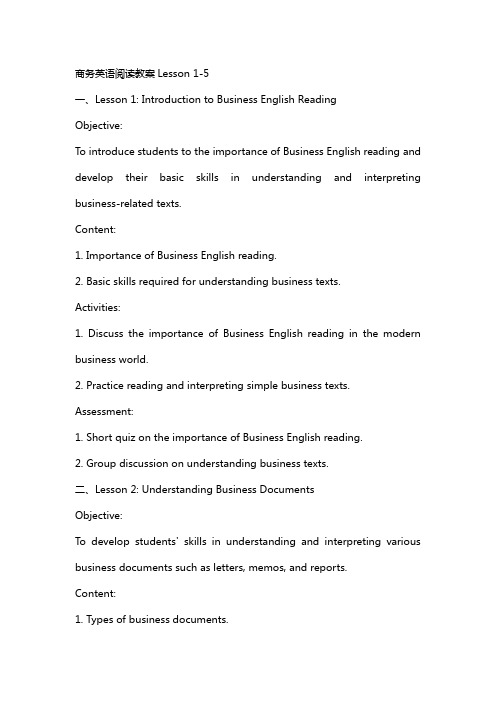
商务英语阅读教案Lesson 1-5一、Lesson 1: Introduction to Business English ReadingObjective:To introduce students to the importance of Business English reading and develop their basic skills in understanding and interpreting business-related texts.Content:1. Importance of Business English reading.2. Basic skills required for understanding business texts.Activities:1. Discuss the importance of Business English reading in the modern business world.2. Practice reading and interpreting simple business texts. Assessment:1. Short quiz on the importance of Business English reading.2. Group discussion on understanding business texts.二、Lesson 2: Understanding Business DocumentsObjective:To develop students' skills in understanding and interpreting various business documents such as letters, memos, and reports.Content:1. Types of business documents.2. Skills required for understanding business documents.Activities:1. Analyze and discuss different types of business documents.2. Practice reading and interpreting sample business documents. Assessment:1. Group activity to identify and classify different types of business documents.2. Individual assignment to read and summarize a business document.三、Lesson 3: Reading Business NewsObjective:To develop students' skills in reading and understanding business news articles, reports, and editorials.Content:1. Types of business news.2. Skills required for reading business news.Activities:1. Discuss different types of business news and their importance.2. Practice reading and interpreting sample business news articles. Assessment:1. Group discussion on understanding business news articles.2. Individual quiz on identifying and analyzing business news sources.四、Lesson 4: Understanding Financial StatementsObjective:To develop students' skills in reading and interpreting financial statements such as balance sheets, ine statements, and cash flow statements.Content:1. Types of financial statements.2. Skills required for understanding financial statements.Activities:1. Analyze and discuss different types of financial statements.2. Practice reading and interpreting sample financial statements. Assessment:1. Group activity to analyze and interpret a sample financial statement.2. Individual assignment to read and summarize a financial statement.五、Lesson 5: Reading Business Reports and ProposalsObjective:To develop students' skills in reading and understanding business reports and proposals.Content:1. Types of business reports and proposals.2. Skills required for reading business reports and proposals. Activities:1. Discuss different types of business reports and proposals.2. Practice reading and interpreting sample business reports and proposals.Assessment:1. Group activity to identify and classify different types of business reports and proposals.2. Individual assignment to read and summarize a business report or proposal.六、Lesson 6: Understanding Business CorrespondenceObjective:To develop students' skills in reading and understanding business letters, es, and memos.Content:1. Types of business correspondence.2. Skills required for understanding business correspondence. Activities:1. Discuss different types of business correspondence and their purposes.2. Practice reading and interpreting sample business letters, es, and memos.Assessment:1. Group activity to analyze and respond to a business correspondence scenario.2. Individual assignment to read, analyze, and draft a business letter or e.七、Lesson 7: Analyzing Business Case StudiesObjective:To develop students' skills in reading and analyzing business case studies to understand real-world business situations and solutions. Content:1. Types of business case studies.2. Skills required for analyzing business case studies.Activities:1. Discuss different types of business case studies and their significance.2. Practice reading and analyzing sample business case studies. Assessment:1. Group activity to analyze and discuss a business case study.2. Individual assignment to read, analyze, and present findings from a business case study.八、Lesson 8: Reading Business Contracts and Agreements Objective:To develop students' skills in reading and interpreting business contracts and agreements.Content:1. Types of business contracts and agreements.2. Skills required for reading business contracts and agreements.Activities:1. Analyze and discuss different types of business contracts and agreements.2. Practice reading and interpreting sample business contracts and agreements.Assessment:1. Group activity to analyze and interpret a sample business contract or agreement.2. Individual assignment to read, understand, and summarize a business contract or agreement.九、Lesson 9: Enhancing Reading Comprehension Strategies Objective:To enhance students' reading prehension strategies for better understanding of plex business texts.Content:1. Different reading prehension strategies.2. Applying these strategies to business texts.Activities:1. Discuss and learn different reading prehension strategies.2. Practice applying these strategies to sample business texts. Assessment:1. Group activity to demonstrate reading prehension strategies.2. Individual quiz on applying reading prehension strategies to a business text.十、Lesson 10: Evaluating and Critiquing Business TextsObjective:To develop students' skills in evaluating and critiquing business texts for their accuracy, effectiveness, and relevance.Content:1. Criteria for evaluating business texts.2. Skills required for critiquing business texts.Activities:1. Discuss the criteria for evaluating business texts.2. Practice critiquing sample business texts.Assessment:1. Group activity to evaluate and critique a business text.2. Individual assignment to read, evaluate, and write a critique of a business text.重点和难点解析一、Lesson 1 中的重点环节是理解商务英语阅读的重要性以及培养理解商务文本的基本技能。
商务英语教资教案模板范文
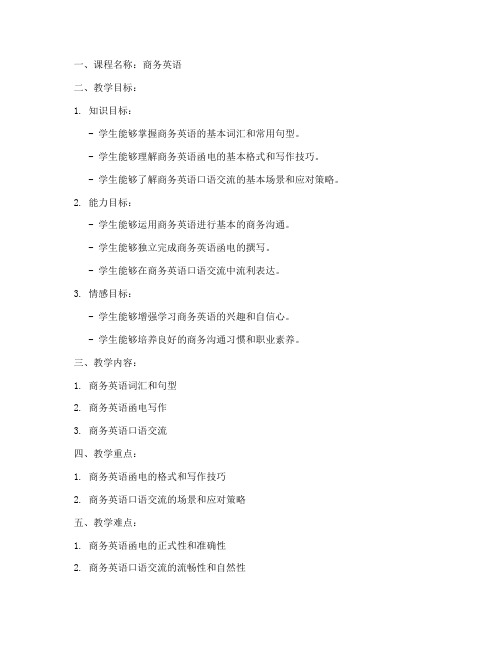
一、课程名称:商务英语二、教学目标:1. 知识目标:- 学生能够掌握商务英语的基本词汇和常用句型。
- 学生能够理解商务英语函电的基本格式和写作技巧。
- 学生能够了解商务英语口语交流的基本场景和应对策略。
2. 能力目标:- 学生能够运用商务英语进行基本的商务沟通。
- 学生能够独立完成商务英语函电的撰写。
- 学生能够在商务英语口语交流中流利表达。
3. 情感目标:- 学生能够增强学习商务英语的兴趣和自信心。
- 学生能够培养良好的商务沟通习惯和职业素养。
三、教学内容:1. 商务英语词汇和句型2. 商务英语函电写作3. 商务英语口语交流四、教学重点:1. 商务英语函电的格式和写作技巧2. 商务英语口语交流的场景和应对策略五、教学难点:1. 商务英语函电的正式性和准确性2. 商务英语口语交流的流畅性和自然性六、教学方法:1. 讲授法:讲解商务英语的基本知识和技巧。
2. 案例分析法:通过分析真实的商务英语案例,帮助学生理解应用。
3. 小组讨论法:分组进行商务英语函电撰写和口语交流练习。
4. 角色扮演法:模拟商务场景,让学生实际运用所学知识。
七、教学过程:第一课时:商务英语词汇和句型1. 导入:简要介绍商务英语的重要性及其在日常商务活动中的应用。
2. 词汇教学:讲解商务英语中常见的词汇,如“import”、“export”、“order”、“invoice”等。
3. 句型教学:讲解商务英语中常用的句型,如“May I have your attention, please?”、“We are interested in your products”等。
4. 练习:让学生根据所学词汇和句型进行简单的对话练习。
第二课时:商务英语函电写作1. 导入:介绍商务英语函电的基本格式和写作技巧。
2. 案例分析:分析真实的商务英语函电案例,讲解函电的写作要点。
3. 练习:让学生根据所学知识撰写商务英语函电。
第三课时:商务英语口语交流1. 导入:介绍商务英语口语交流的场景和应对策略。
商务英语综合教案设计模板

一、课程名称商务英语综合二、教学目标1. 知识目标:- 掌握商务英语的基本词汇和语法结构。
- 了解商务英语常用的表达方式和沟通技巧。
- 熟悉商务场景中的常用用语和礼仪。
2. 能力目标:- 提高学生的商务英语听说读写能力。
- 培养学生的商务英语沟通能力和跨文化交际能力。
- 增强学生的商务英语应用能力和实际操作能力。
3. 情感目标:- 激发学生对商务英语学习的兴趣。
- 培养学生的团队合作精神和责任感。
- 增强学生的自信心和竞争意识。
三、教学内容1. 商务英语词汇:包括基础词汇、行业词汇和常用短语。
2. 商务英语语法:包括时态、语态、虚拟语气等。
3. 商务英语听力:包括商务场景对话、新闻报告、访谈等。
4. 商务英语口语:包括商务场景对话、角色扮演、演讲等。
5. 商务英语阅读:包括商务文章、报告、案例分析等。
6. 商务英语写作:包括商务信函、报告、简历等。
四、教学方法1. 讲授法:讲解商务英语基础知识,引导学生掌握核心词汇和语法结构。
2. 案例分析法:通过分析真实商务案例,提高学生的实际操作能力。
3. 角色扮演法:模拟商务场景,让学生在实际对话中提高听说能力。
4. 小组讨论法:鼓励学生积极参与课堂讨论,培养团队合作精神。
5. 多媒体教学法:利用多媒体资源,丰富教学内容,提高学生的学习兴趣。
五、教学过程1. 导入新课:通过介绍商务英语的重要性,激发学生的学习兴趣。
2. 新课讲解:讲解商务英语基础知识,引导学生掌握核心词汇和语法结构。
3. 案例分析:分析真实商务案例,让学生了解商务英语在实际应用中的运用。
4. 角色扮演:模拟商务场景,让学生在实际对话中提高听说能力。
5. 小组讨论:分组讨论,让学生在讨论中巩固所学知识,提高团队协作能力。
6. 练习巩固:布置课后练习,巩固所学知识。
7. 总结回顾:对本节课所学内容进行总结,帮助学生梳理知识体系。
六、教学评价1. 课堂表现:观察学生在课堂上的参与度、积极性等。
2. 课后作业:检查学生的课后练习,了解学生对知识的掌握程度。
剑桥商务英语初级教案
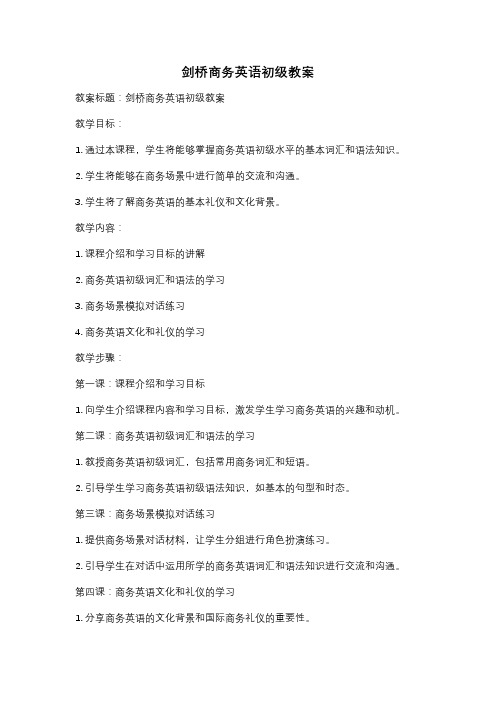
剑桥商务英语初级教案教案标题:剑桥商务英语初级教案教学目标:1. 通过本课程,学生将能够掌握商务英语初级水平的基本词汇和语法知识。
2. 学生将能够在商务场景中进行简单的交流和沟通。
3. 学生将了解商务英语的基本礼仪和文化背景。
教学内容:1. 课程介绍和学习目标的讲解2. 商务英语初级词汇和语法的学习3. 商务场景模拟对话练习4. 商务英语文化和礼仪的学习教学步骤:第一课:课程介绍和学习目标1. 向学生介绍课程内容和学习目标,激发学生学习商务英语的兴趣和动机。
第二课:商务英语初级词汇和语法的学习1. 教授商务英语初级词汇,包括常用商务词汇和短语。
2. 引导学生学习商务英语初级语法知识,如基本的句型和时态。
第三课:商务场景模拟对话练习1. 提供商务场景对话材料,让学生分组进行角色扮演练习。
2. 引导学生在对话中运用所学的商务英语词汇和语法知识进行交流和沟通。
第四课:商务英语文化和礼仪的学习1. 分享商务英语的文化背景和国际商务礼仪的重要性。
2. 讨论不同文化背景下的商务交流差异,并提供实际案例进行分析和讨论。
教学评估:1. 通过课堂练习和角色扮演,评估学生对商务英语词汇和语法的掌握程度。
2. 通过小组讨论和案例分析,评估学生对商务英语文化和礼仪的理解和应用能力。
教学资源:1. 剑桥商务英语初级教材和练习册2. 商务英语词汇和语法练习题3. 商务场景对话材料和角色扮演指导4. 商务英语文化和礼仪案例分析材料教学反思:1. 根据学生的学习情况和反馈,及时调整教学内容和方法,提供个性化的辅导和指导。
2. 鼓励学生自主学习和实践,提供额外的学习资源和练习材料。
商务英语综合教案模板范文

一、课程名称:商务英语综合二、课时安排:2课时三、教学目标:1. 让学生掌握商务英语的基本词汇和常用句型。
2. 提高学生的商务英语听说读写能力。
3. 培养学生运用英语进行商务沟通的能力。
4. 增强学生的商务礼仪和跨文化交际意识。
四、教学内容:1. 商务英语基础词汇和句型2. 商务英语听说读写技能训练3. 商务邮件写作4. 商务谈判技巧5. 跨文化交际与商务礼仪五、教学过程:第一课时:1. 导入新课(1)教师简要介绍商务英语的重要性及课程安排。
(2)播放一段商务英语视频,让学生了解商务英语的实际应用场景。
2. 商务英语基础词汇和句型(1)教师讲解商务英语基础词汇,如:market、product、customer、sales、order等。
(2)教师引导学生练习常用句型,如:How are you doing? What can I do for you? Can I help you?3. 商务英语听说读写技能训练(1)教师播放一段商务英语听力材料,让学生进行听力练习。
(2)教师讲解商务英语阅读技巧,如:快速浏览、关键词定位等。
(3)教师带领学生进行商务英语写作练习,如:撰写商务邮件。
4. 总结本节课所学内容,布置课后作业。
第二课时:1. 复习上节课所学内容(1)教师提问,检查学生对商务英语基础词汇和句型的掌握情况。
(2)教师检查学生课后作业完成情况。
2. 商务邮件写作(1)教师讲解商务邮件的格式和注意事项。
(2)教师带领学生进行商务邮件写作练习,如:回复客户咨询、发送订单确认等。
3. 商务谈判技巧(1)教师讲解商务谈判的基本原则和技巧。
(2)教师组织学生进行角色扮演,模拟商务谈判场景。
4. 跨文化交际与商务礼仪(1)教师讲解不同文化背景下的商务礼仪差异。
(2)教师组织学生进行跨文化交际练习,如:问候、介绍、道别等。
5. 总结本节课所学内容,布置课后作业。
六、教学评价:1. 课堂表现:学生的出勤率、课堂参与度、作业完成情况。
商务英语全册教案.docx
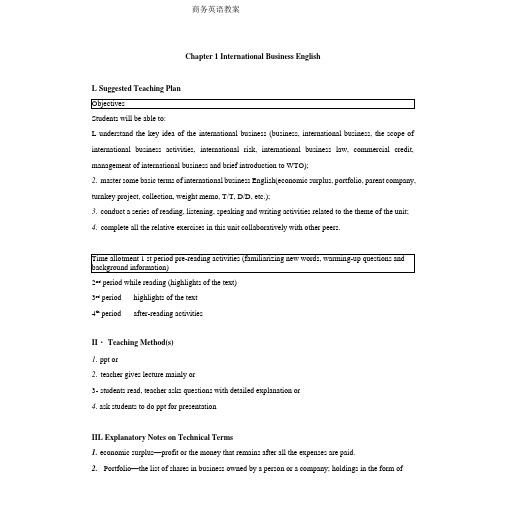
商务英语教案Chapter 1 International Business EnglishL Suggested Teaching PlanStudents will be able to:L understand the key idea of the international business (business, international business, the scope of international business activities, international risk, international business law, commercial credit, management of international business and brief introduction to WTO);2.master some basic terms of international business English(economic surplus, portfolio, parent company, turnkey project, collection, weight memo, T/T, D/D, etc.);3.conduct a series of reading, listening, speaking and writing activities related to the theme of the unit;plete all the relative exercises in this unit collaboratively with other peers.2nd period while reading (highlights of the text)3rd period highlights of the text4th period after-reading activitiesII・ Teaching Method(s)1.ppt or2.teacher gives lecture mainly or3- students read, teacher asks questions with detailed explanation or4. ask students to do ppt for presentationIIL Explanatory Notes on Technical Terms1.economic surplus—profit or the money that remains after all the expenses are paid.2.Portfolio—the list of shares in business owned by a person or a company; holdings in the form ofstocks, bonds or other securities.3. a parent company—holding company.4.turnkey project—a project undertaken by a contractor.5.expropriation—taking away (property) or dispossessing (sb. from an estate, etc.).6- collection — obtaining payment of a debt, e.g. a bill, cheque, etc.7. coiTespondent bank—a bank that has regular business with another bank or company in a distance place(esp. in a foreign country).& insunnice policy—a document issued by the insurer, setting out the exact terms and conditions of an insurance transaction.9.insurance certificate—a simplified insurance policy.10.weight memo(note) —a note made out by a seller and used to indicate the net and gross weights of each package.IV. Detailed readingWarming-up questions1.How much do you know about international business?2.Can you say something about the basic purpose of business activities?3.Do you know what features does international business deal with?Contents1.What is Business?•Traditionally,exchange or trade for things people wanted or needed•Technically, the production, distribution, and sale of goods and service for a profit•The primary goal of business activities is creating profit or economic surplus2.What is International Business?•As a field of management training, it deals with the special features of business activities that cross national boundaries including movements of goods, services, capital, or personnel; transfers of technology, information, or data, or even the supervision of employees.•The international business field encompasses international transactions in commodities, internationaltransfers of intangibles such as technology and data, and the performance of international services such as banking and transportation. It gives special attention to the multinational enterprises — an enterprise based in one country and operating in one or more other countries_ and the full methods open to such enterprises for doing business internationally.3.The Scope of International Business Activities•Physical goods—products from mining, petroleum, agriculture and manufacturing activities •Transactions in service —construction, hotel, tourism, business consulting, and retailing and wholesaling, transportation•Financial areas — commercial and investment banking, securities, and insurance •Communication media—radio, television, telegraph, telephone, magazines, books, newspapers, news services, networks and movies.•* foreign direct investment — investment that give the investor effective control and are accompanied by managerial participation.*portfolio(有彳介证券)investment— for the sake of obtaining investment income or capital gains rather than entrepreneurial income.^different ways of financing in foreign direct investment— not through capital movement abroad, but by borrowing locally, reinvesting foreign earnings, by the sale to the foreign affiliate of non-financial assets such as technology, or through funds generated by licensing fees and payments for management services to the parent company.*direct investment includes whole ownership and a joint venture with one or more partners, who may be private firms or governments in the host country or other international firms of different nationalities.4.International Risk•Include financial, political, regulatory, and tax risks•Financial risk elements involve balance-of-payments considerations, varying exchange rates, differential inflation trends among countries, and divergent interest rates-•PoHtical risks include the risk of expropriation and other adversary national policies. •regulatory risks arise from different legal systems, overlapping jurisdictions, and dissimilar policies that influence business practices and the application of antitrust law.•In the tax field, unforeseen changes in fiscal policies and the uncertainty of application of tax laws.5・ On International Business Law•The movement of people ______ v isa, work permit, employment agreement, and employment termination clauses•The movement of goods ____ tax, antitrust, packaging and advertising•Transfers of information ___ pate nt and trademark•Domestic laws of the home and host states, trade rules of regional groups(EU, WTO), and multilateral and bilateral treaties between the home and host statesmercial Credit•Credit ___ means who takes the responsibility of paying money and surrendering the shipping documents which represent the title to the goods in handing over the transacted goods and paying the above said money.• A. Commercial credit _____ remittance (汇付)and collection (托收),the buyer is responsible tomake payment, the seller to surrender documents-B. banker's credit _____ letter of credit (L/C 信用证),the banker is responsible to pay moneyand tender documents on behalf of both parties.•The buyer can adopt three different ways of remittance when he sends the money to the seller througha bank:1)Mail Transfer (M/T 信汇)The buyer gives money to his local bank. The local bank issues a trust deed for payment(付款委托书),then sends it to a correspondent bank at the seller^ end by means of mail and entrusts him to pay the money to the seller.2)T elegraphic Transfer (T/T 电汇)At the request of the buyer, the local bank sends a trust deed for payment by cable directly to a correspondent bank at the seller's end and entrust him to pay money to the seller.This method is quicker than mail transfe匸The seller can receive the money at an early date. But the buyer has to bear more expenses.3)Demand Draft (D/D 票汇)The buyer buys a bank draft (汇票)firom his local bank and sends it by mail to the seller. On thebasis of the above bank draft, the seller or his appointed person takes the money from the relative bank in his place.•Collection (托收)The seller issues a draft, to which the shipping documents are attached, forwards the draft to a bank in his place (i.e., the remitting bank 托H攵g艮彳亍或受托银彳亍),makes an application for collection and entrusts the remitting bank to collect the purchase price from the buyer through its correspondent bank abroad (ie, the collecting bank 代收银行).Because the remitting bank instructs the collecting bank not to part the documents with the latter until the draft is accepted or paid(承兑或支彳、J ), the buyers lack of commercial integrity is guarded against.•D/P ____ documents against payment (付款交单)The exporter is to ship the goods ordered and deliver the relative shipping documents to the buyer abroad thorough the remitting bank and the collecting bank with instructions not torelease the documents to the buyer until the payment for the goods is made.•Why cannot the buyer directly send cash or banker^s draft with his order to the seller?1)t he buyercapital will be tied up from the time of remitting it until the goods arrive and are sold, especially in cases where the goods ordered can only be shipped by the sellermonths or years after placing the order.2)T he seller may be unknown to the buyer, and his commercial integrity may be questionable.•Insurance policy (保险单)- a document issued by the insurer, setting out the exact terms and conditions of an insurance transaction _ the name of the insured, the name of commodity insured, the amount insured, the name of the carrying vessel, the precise risks covered, the period of cover, and any exceptions there may be. It is also a written contract of insurance between the insurance company and the insured.•Insurance certificate(保险凭证)一is a simplified insurance policy. It has the necessary items of an insurance policy, but it doesn't set out the rights and duties of the insurer and the insured, which are subject to the detailed insurance clauses of a fonnal insurance policy. In insurance certificate has the same effect as an insurance policy•Weight memo(重量单)is made out by a seller when a sale is affected in foreign trade, indicating the net and gross weights of each package, which enables the consignee or the customs office to check the goods.•Packing list(装箱单)- is made out by a seller when a sale is affected in foreign trade, indicating the name of the goods, the net weight, the gross weight and complete inner packing specifications and contents of each package. It enables the consignee to declare the goods at the customs office, distinguish and check the goods when they arrive at the port of destinations.7.On Management of International Businesses•Regardless of the specific job, most managers perform five basic functions.1)p lanning_ involves determining overall company objectives and deciding how these goals can best be achieved・2)O rganizing _ is the process of putting the plan into action. The most important is allocating resources, especially human resources, deciding on the positions to be createdand determining the associated duties and responsibilities.3)T he day-to-day direction and supervision of employees — make the full of the potentials of the employees and achieve the company goals.4)C oordinating_ to bring into proper relations among the various departments ofthe company.5)Con trolling __ managers evaluate how well company objectives are being met.If not met, then changes are necessary in the company^ organizational or managerialstructure. Then replan, reorganize, redirect, recoordinate.& Brief Introduction of WTO•WTO was established on 1 January 1995. It is the legal and institutional foundation of the multilateral trading system. It provides the principal contractual obligations determining how governments frame and implement domestic trade legislation and regulations. And it is the platform on which trade relations among countries evolve through collective debate, negotiation and adjudication•It is based in Geneva, Switzerland-•Its essential functions are:_ administering and implementing the multilateral and plural-lateral trade agreements which together make up the WTO;—acting as a forum for multilateral trade negotiations;_ seeking to resolve trade disputes;__ overseeing national trade policies; and__ cooperating with other international institutions involved in global economic policy-making. •The structure of the WTO is dominated by its highest authority, the Ministerial Conference, composed of representatives of all WTO members, which is required to meet at least every two years and which can make decisions on all matters under any of the multilateral trade agreements.V After-reading activitiesA.Try to do the exercises according to the text.prehension of the textAnswer the following questions1). What is the definition of business today?2). What's the scope of International business activities?3). What is the definition of foreign direct investment?4). How do we treat the international risk?5). What are the management functions in international business?6). What does the word "credit^ mean? What's the commercial credit?7). What ways of remittance can the buyer adopt when he sends the money to the seller?2.Explain the following key termsRemittance, collection, D/P, D/D, T/T, packing list, insurance policy, turkey project, weight memoB.Make a presentation about WTO in groups.Chapter 2 Business OrganizationsL Suggested Teaching Plan1.understand the basic idea of business organizations;2.master some key types of business organizations (corporation, general partnership, limited partnership, sole proprietorship, professional corporation, joint-stock companies, business trusts and joint ventures, etc.);3.conduct a series of reading, listening, speaking and writing activities related to the theme of the unit;plete all the relative exercises in this unit collaboratively with other peers.2nd period while reading (highlights of the text)3rd period highlights of the text4lh period after-reading activitiesIL Teaching Method(s)1.ppt or2.teacher gives lecture mainly or3.students read, teacher asks questions with detailed explanation or4.ask students to do ppt for presentationIIL Explanatory Notes on Technical Terms1.proprietorship—ownership.2.stockholder—one who owns stock in a company.3.partnership—unregistered business where two or more people agree to share, not necessarily equally, in the risks and profits of the organization..4.entity—something that has a real and separate existence.5• bankruptcy—state of being declared by a court of law not to be capable of paying its debts.6.Joint-stock company—public company whose shares are owned by very many people.7.dividend—percentage of profits paid to shareholders.6bylaw—a law or rule governing the internal affairs of an organization.9. treasurei•—person who looks after the money or finance of a club or society.1()・ comptroller—financial controller.IV. Detailed readingWarming-up questions1.How much do you know about business organizations?2.Can you say something about the different types of companies?3.Do you know the difference between sole proprietorship and partnership?1.Introduction•The majority of business organizations are corporations, others are general partnerships(一般合伙企业),limited partnerships (有限合伙企业),and sole proprietorships (独资企业).Less common are professional corporations(专业公司),joint-stock companies (合月殳公司),business trusts (商业信托)and joint ventures (合资企业)-The factors to be weighted in making the decision are ease of formation, financial resource available, control, taxation, management skills available, ability to raise capital, continuity, and legal capacity.2.Sole Proprietorship— is owned by a single person>•The principal advantage of the sole proprietorship is that the owner has exclusive control over its operations without accounting to board members, partners, or stockholders.•Disadvantages ___ first, the owner is exposed to unlimited liability. Second , it is normally not in the best position to raise large sum of money. Third, the lack of continuity. If the owner dies, or becomes too ill to continue operation of the business, there is no separate legal entity in existence with which the public, creditors, or suppliers can deal to ensure the continu让y of the business.3.General Partnership _ is an association of two or more persons to carry on, as co-owners, abusiness for profit, (the common law does not recognize a partnership as a legal entity, but usually as an aggregation of individuals. Thus, unlike a corporation, a partnership is not a fictional person with a distinct legal existence apart from its members.)•Does not require a formal written agreement, an agreement in writing contains names of the partners, name, location, purposes, duration of the partnership, allocation of profits and lossesamong partners, capital contributions by partners, partnersrights and responsibilities, dissolution procedures.•Dissolution by act of the parties ____ 1) by agreement; 2) withdrawal or addition of a partner; 3) violation of the partnership agreement by one of the parties; of 4) accomplishment of the purpose for which the partnership was formed.•Dissolution by operation of law ____ 1) by the death of a partner; 2) the bankruptcy of a partner or the partnership; 3) the illegality of the partnership; or 4)by order of a court.•Termination_ even though the partnership is dissolved, it does not actually terminate until the partnership affairs are completed.•Liquidation ___ o ccurs between dissolution and termination. During this process, business affairs are put in order, receivables are collected, accountings are made, payments to creditors are made, and the remaining assets are distributed to the partners as provided in the Uniform Partnership Act.4.Limited Partnership ___ one or more partners in the limited partnership have limited liability,that is, their liability is limited to the extent of their investment in the partnership, and the limited partners have no control over the everyday management of the partnership. The limited partnership involves passive investors who are like shareholders in a corporation. Thus limited partnership has features of both a general partnership and a corporation.5- Joint Stock Company —is an unincorporated business enterprise with the ownership interest represented by shares of stock. It can be created with little formality and no initial capital outlay is required, (they are rarely seen now.) The shareholders are personally liable for all the association's obligations, while they share the profits in proportion to their controlling interest in the company.The joint stock company is controlled by a board of directors and officers.6.Corporations•Features: 1) a corporation is a separate legal entity for all purposes.2)it is not mortal theoretically. It continues until dissolved, merged, or otherwise terminated.3)the owners of the corporation, called shareholders, enjoy limited liability.4)it is easy to transfer ownership interests by buying or selling shares of stock freely.5)the separation of ownership from management.6)it pays taxes on its earnings.7)the corporate forni requires compliance with an array of formalized procedures. And government more closely supervises corporations than partnerships or sole proprietorships.•Types of corporations1)public coiporation ___ are established by the goveniment. (eg. The U.S. PostalService)2)quasi-public corporations_ are public service companies, such as public utilities.3)Private corporations ____ are those established for private interest. Privatecorporation may further be divided between nonprofit and profit. Nonprofit ones areformed for charitable or religious purposes. Profit ones are usually formed to carry outbusiness.4)Profit corporation are further divided into professional专业公司),closely held(私募公司),and publicly held (公募公司).•Corporation managementShareholders elect a board of directors to manage the corporation. The board, in turn, delegates the clay to day operations to officers. The directors and the officers comprise the management of the corporation. The board of directors are responsible for making the policy of the company, declaring dividends, proposing amendments to articles of incorporation and bylaws, proposing candidates for the board and removing officers. Officers are appointed by the board of directors pursuant to the bylaws and are responsible for implementing the policies of the board and for the oversight of the day to day operations of the business. Officers include a president, vice presidents, secretary, and treasurer.•Shareholders1)common shareholders and prefeixed shareholders2)prefeiTed shareholders are entitled to receive their dividends before common shareholders-On dissolution, preferred shareholders are entitled to distributions of assets before commonshareholders. Common shareholders have voting rights whereas preferred stockholdersnormally can vote only on extraordinary matters.• Dividends — are portions of corporate earnings distributed to shareholders. A board maintains almostabsolute discretio n to declare or not declare divide nds. Dividends may be in the form of cash or stock.V After-reading activitiesA.Try to do the exercises according to the text.prehension of the textAnswer the following questions1)- What are the major disadvantages of sole proprietorship?2). What are the chief difference between general partnership and limited partnership?3). Is general partnership a legal entity?4). Why is it desirable to have articles of partnership as far as partnership is concerned?5). What has to be dealt with between dissolution and termination of a partnership?6). What are the main advantages and disadvantages of joint-stock company?7). Which feature makes a corporation attractive to investors? Why?2.Explain the following termsl)Sole proprietorship 2)general partnership3)limited partnership, 4)coiporation5)joint-stock company3.Translate the following economic terms into English1)独资商2)普通合伙商3)法人4)合股公司5)董事会6)国有公司7)资本摊缴8)多数股权9)优先股股东10)公司章程B.Make a presentation about the advantages and disadvantages of different types of business organizations in groups.Chapter 3 Ways of BusinessL Suggested Teaching PlanStudents will be able to: 1 .understand the idea of the different ways of business (wholesaling, retailing, franchising, agency, and electronic commerce);2.master some key terms of ways of business;3.conduct a series of reading, listening, speaking and writing activities related to the theme of the unit;plete all the relative exercises in this unit collaboratively with other peers.2nd period while reading (highlights of the text) 3rd period highlights of the text 4th period after-reading activitiesII・ Teaching Method(s)1.ppt or2.teacher gives lecture mainly or3- students read, teacher asks questions with detailed explanation or4.ask students do ppt to do presentationIIL Explanatory Notes on Technical Terms1.intermediary—agent or other person or firm through whom business is done.2.Merchandising—organizing the display and promotion of goods for sale.3.Bookkeeping—keeping of the financial records of a company or an organization..4.broker—person who acts as a middleman in negotiating bargains or contracts.5.franchise—business arrangement in which an individual obtains rights from a larger company to sella well-known product or service.6.Royalty—share of profits or receipts paid to an owner of a pate nt, copyright for the use of it.7.fraudulent—characterized by, constituting, or gained by fraud・8.principal — person or company which is represented by an agent.9.fiduciary—trustee pertaining to the holding of something in trust.IV. Detailed readingWarming-up questions1.How much do you know about different ways of doing business?2.Can you say something about the distinction between wholesaling and wholesalers?3.Do you know what is retailing?ContentsL Introduction2.Wholesaling_ includes all marketing transactions in which purchases are intended for resale or areused in making other products. It is not exchange with ultimate consumers, but with industrial, reseller and institutional users, including other wholesalers who act as intermediaries in buying products for, or selling products to, other middlemen.3.Retailing ___ retail exchanges are entered into for personal, family, or household purposes. Itmay take place in a store, or in-home selling, vending machine, or mail-order catalogues.•By providing assortments of products that match consumer's wants, retailers create place, time and possession utilities.•Product assortments•Major types of retail stores: department stores, mass merchandisers and specialty stores, non-store retailers, franchisers, planned shopping centers.4.Franchising(特许经营权) __ is a license to operate an individually owned business as thoughit were part of a chain of outlets or stores.•Three types:1)product franchise—g. Car dealers and gasoline station2)manufacturing franchise ____ eg. Soft-drink bottling plant3)business-format franchise ___ fast food chains•advantages of franchise1)to the franchiser2)to the franchisee3)to the public•disadvantages of franchise_ no guarantee of wealth, cost more to buy a franchise, pay royalty to franchiser, little independence5.Agency_ an agent acts on behalf of another. The party for whom an agent acts is the principal. Agentshave authority to bind their principals. Agents may enter into contracts on behalf of their principals.And principals are liable for the tortuous acts committed by agents within the scope of their agency.•Three types of agents1)ordinary agents2)general agents3)sole agents6.Electronic Commerce•The advantages and disadvantages of E-commerce (open for discussion)V After-reading activitiesA.Try to do the exercises according to the textprehension of the text.Answer the following questions1). What functions are performed by wholesalers?2). What?s the importance of retailing?3). What utilities do retailers create?4). What do specialty retailers have in common?5). What are the major distinctions between discount houses and department stores?6). What does the typical franchises gain from the franchiser?7). Will a franchise necessarily be successful? Why?8)In what way may a principal-agency relationship terminate?2.Explain the following key termsWholesaling, retailing, discount house, franchising, principal3.Translate the following business terms into English.1)最终消费者2)增值价值3)批发商4)产品花色品种5)地方效用6)邮售7)地方商店8)现金流量9)存货控制10)市场分区/分片B.Make a presentation about the advantages and disadvantages of different kinds of ways of business in groups.Chapter 4 International Trade TermsL Suggested Teaching PlanStudents will be able to:1- understand the key idea of the international trade terms (Incoterms 1990);2.master some basic terms of international business English(FCA, FAS, FOB, CFR, CIF, CPT, CIP, DAF, DES, DEQ, DDU, DDP and EXW);3.conduct a series of reading, listening, speaking and writing activities related to the theme of the unit;plete all the relative exercises in this unit collaboratively with other peers.2nd period while reading (highlights of the text)3rd period highlights of the text4th period after-reading activitiesIL Teaching Method(s)1 • ppt or2.teacher gives lecture mainly or3.students read, teacher asks questions with detailed explanation or4.ask students do ppt to do presentationIIL Explanatory Notes on Technical Terms1.carrier—a company which transports goods or vehicle or ship which transports goods.2.camage—transporting goods from one place to another or cost of transport of goods.3.Free on board (FOB)—price including all the seller's costs until the goods are on the ship for transportation; US price includes all the seller's costs until the goods are delivered to a certain place.4.Cost, Insurance and Freight (CIF) —estimate of a price, which includes the cost of the goods, the insurance and the transport charges.mission—money paid to a salesman or agent, usually a percentage of the sales made.6.discount—a percentage by which a full price is reduced to a buyer by the seller7.CIFC3%—Cost, Insurance, Freight, including a 3% commission.IV. Detailed reading1.How much do you know about international trade terms?2.Can you say something about the most important term among the basic terms and conditions in inlemational business contract?3.Do you know what are the most often used terms and conditions among the price terms and conditions?ContentsL Introduction• What are the basic terms and conditions of the contract in international business?_____ T erms and conditions of quality, quantity, packing, price, delivery, insurance, terms of payment, inspection, claim and arbitration.•USD2000/MT CIF C4% London2.Definition of the Trade Terms in Incoterms 1990EX WORKS (... named place)工厂交货价•It means that the seller delivers when he places the goods at the disposal of the buyer at the seller^ premises or another named place (i.e., works, factory, warehouse, etc.) not cleared for export and not loaded on any collecting vehicle.FCA(Free Carrier ... named place)货交承运人。
商务英语口语教案

商务英语口语教案一、教学目标:1. 掌握商务英语口语基本词汇及表达方式;2. 熟悉商务场景中常用的社交用语;3. 能够进行简单的商务电话沟通。
二、教学内容:1. 商务英语口语基本词汇;2. 商务场景中的社交用语;3. 商务电话沟通技巧。
三、教学步骤:1. 商务英语口语基本词汇的学习a. 介绍商务场景中常用的英语词汇,如meeting(会议)、client(客户)、negotiation(谈判)等;b. 给学生提供相关词汇的发音、词义及用法,并进行练习;c. 设计相关对话情景,让学生进行角色扮演,模拟实际商务场景中的口语表达。
2. 商务场景中的社交用语学习a. 介绍商务社交场合中常用的英语表达方式,如greeting(问候)、introduction(介绍)、thank you(感谢)等;b. 给学生提供相关表达方式的示范和练习;c. 设计相关对话情景,让学生进行角色扮演,模拟实际商务社交场合中的口语表达。
3. 商务电话沟通技巧的学习a. 介绍商务电话沟通的基本流程和注意事项,如打招呼、自我介绍、表达目的、提问、感谢、结束等;b. 给学生提供相关对话示范和练习;c. 设计相关电话情景,让学生进行角色扮演,模拟实际商务电话沟通的口语表达。
四、教学评价:1. 学生角色扮演的表现;2. 学生在商务场景中口语表达的准确性和流畅度;3. 学生在商务电话沟通中的对话技巧和语言运用能力。
五、教学扩展:1. 继续练习商务场景中的口语表达,如商务接待、商务旅行等;2. 引导学生自己寻找商务英语口语实践机会,例如参加商务会议、商务社交活动等;3. 通过商务英语听力材料的使用,强化学生的听力理解和口语表达能力。
六、教学反思:本教案以商务英语口语为主要教学内容,通过词汇学习、对话情景模拟和角色扮演的方式,帮助学生提高商务场景中的口语表达能力。
在教学过程中,教师应充分引导学生参与,培养学生的实际运用能力,并及时进行教学评价和反馈,以提高教学效果。
《商务英语口语》教案

《商务英语口语》教案第一章:商务英语口语概述1.1 课程目标让学生掌握商务英语口语的基本表达方式和技巧。
提高学生在商务场合中的英语口语交流能力。
1.2 教学内容商务英语口语的重要性商务英语口语的特点商务英语口语的基本表达方式1.3 教学方法讲授法:讲解商务英语口语的基本表达方式和技巧。
互动法:引导学生进行商务英语口语练习,提高口语表达能力。
1.4 教学评估课堂参与度:观察学生在课堂上的发言和互动情况。
口语练习:评估学生在口语练习中的表现。
第二章:商务英语口语的基本技巧2.1 语音语调正确发音:讲解商务英语中常见的发音规则。
语调运用:强调在商务英语口语中的语调变化。
2.2 词汇选择商务英语词汇:教授商务英语中常用的词汇和短语。
词汇搭配:讲解商务英语中常见的词汇搭配和用法。
2.3 句型结构简单句型:介绍商务英语中常用的简单句型。
复杂句型:讲解商务英语中常用的复杂句型和连接词。
2.4 商务英语口语的表达方式礼貌用语:教授商务英语中的礼貌用语和表达方式。
商务话题表达:讲解商务英语中常见话题的表达方式。
第三章:商务英语口语的实践应用3.1 商务电话沟通电话接听和拨打电话的礼貌用语商务电话沟通的技巧和注意事项3.2 商务会议交流会议准备和开场白的表达方式3.3 商务洽谈与签约商务洽谈的流程和常用表达方式商务签约时的口语表达和礼仪注意事项3.4 商务演讲与报告演讲的开场白和结尾表达方式报告中的数据和信息呈现技巧第四章:商务英语口语的商务场景模拟4.1 模拟商务场景一:接待客户接待客户时的问候和介绍自己带领客户参观公司和介绍产品4.2 模拟商务场景二:商务宴请商务宴请的邀请和宴会中的交流餐桌礼仪和商务英语口语表达4.3 模拟商务场景三:商务旅行商务旅行中的预订和接待商务旅行中的交流和合作4.4 模拟商务场景四:商务会议会议前的准备和开场白第五章:商务英语口语的综合练习5.1 口语练习一:商务电话沟通模拟商务电话沟通情景,进行角色扮演练习。
商务英语阅读教案lesson
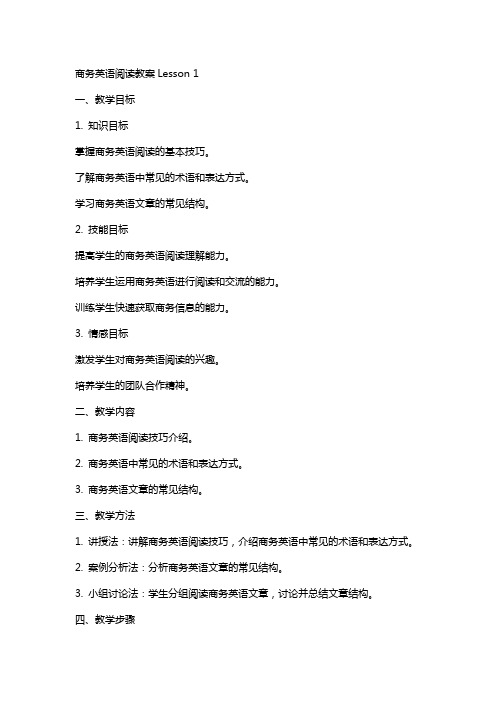
商务英语阅读教案Lesson 1一、教学目标1. 知识目标掌握商务英语阅读的基本技巧。
了解商务英语中常见的术语和表达方式。
学习商务英语文章的常见结构。
2. 技能目标提高学生的商务英语阅读理解能力。
培养学生运用商务英语进行阅读和交流的能力。
训练学生快速获取商务信息的能力。
3. 情感目标激发学生对商务英语阅读的兴趣。
培养学生的团队合作精神。
二、教学内容1. 商务英语阅读技巧介绍。
2. 商务英语中常见的术语和表达方式。
3. 商务英语文章的常见结构。
三、教学方法1. 讲授法:讲解商务英语阅读技巧,介绍商务英语中常见的术语和表达方式。
2. 案例分析法:分析商务英语文章的常见结构。
3. 小组讨论法:学生分组阅读商务英语文章,讨论并总结文章结构。
四、教学步骤1. 导入:简要介绍商务英语阅读的重要性。
2. 讲解:讲解商务英语阅读技巧,介绍商务英语中常见的术语和表达方式。
3. 案例分析:分析商务英语文章的常见结构。
4. 小组讨论:学生分组阅读商务英语文章,讨论并总结文章结构。
5. 总结:总结本节课所学内容,布置作业。
五、作业1. 课后阅读一篇商务英语文章,总结文章结构。
2. 复习本节课所学的商务英语阅读技巧,并进行练习。
商务英语阅读教案Lesson 2(请按照上述格式,继续编写Lesson 2至Lesson 5的教案内容。
)六、教学内容1. 商务英语文章的阅读策略。
2. 提高阅读速度和理解力的技巧。
3. 商务英语文章中图表和数据的理解。
七、教学方法1. 演示法:展示如何有效地阅读商务英语文章。
2. 实践法:通过实际阅读练习来提高学生的阅读技巧。
3. 反馈法:为学生提供阅读后的反馈,帮助他们改进。
八、教学步骤1. 复习:回顾上一节课所学的商务英语阅读技巧。
2. 文章阅读:学生阅读一篇商务英语文章,注意阅读策略的运用。
3. 小组讨论:学生分组讨论文章中的图表和数据,分享理解心得。
4. 速度挑战:进行阅读速度挑战,学生尝试在规定时间内完成阅读。
中职英语教案
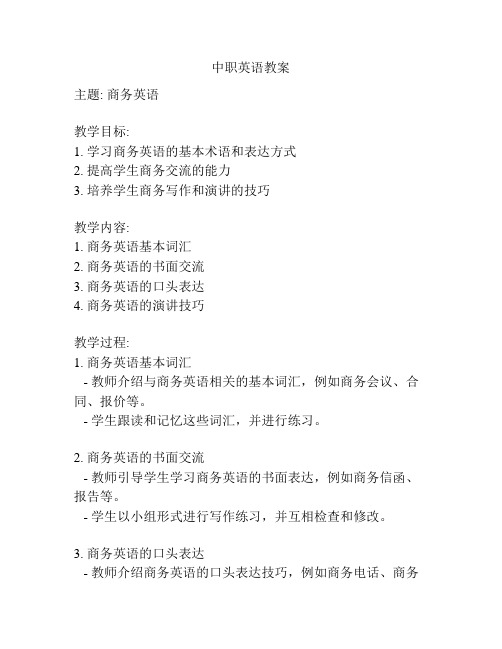
中职英语教案
主题: 商务英语
教学目标:
1. 学习商务英语的基本术语和表达方式
2. 提高学生商务交流的能力
3. 培养学生商务写作和演讲的技巧
教学内容:
1. 商务英语基本词汇
2. 商务英语的书面交流
3. 商务英语的口头表达
4. 商务英语的演讲技巧
教学过程:
1. 商务英语基本词汇
- 教师介绍与商务英语相关的基本词汇,例如商务会议、合同、报价等。
- 学生跟读和记忆这些词汇,并进行练习。
2. 商务英语的书面交流
- 教师引导学生学习商务英语的书面表达,例如商务信函、报告等。
- 学生以小组形式进行写作练习,并互相检查和修改。
3. 商务英语的口头表达
- 教师介绍商务英语的口头表达技巧,例如商务电话、商务
接待等。
- 学生进行角色扮演练习,模拟商务场景进行口语交流。
4. 商务英语的演讲技巧
- 教师讲解商务演讲的基本要素,例如演讲结构、语言运用等。
- 学生准备并进行商务主题的演讲,互相评价和提供建议。
教学评价:
1. 写作练习和口语练习的成绩评定
2. 演讲评价和建议提供
教学延伸:
1. 学生可以通过参加商务英语竞赛等活动来提高自己的商务英语能力。
2. 学生可以通过阅读商务英语相关的书籍和资料来拓宽自己的商务英语知识。
教学资源:
1. 商务英语教材和课件
2. 商务英语相关的练习题和模拟场景
3. 商务英语相关的书籍和资料。
商务英语教案中职

商务英语教案中职【篇一:实用商务英语全套教案(学习中)】目录第一版块:介绍自己、他人、公司及产品第1知识点:正确使用称呼和常见的英文名 2-5 第2知识点:常见的国家和城市6-7 第3知识点:介绍公司部门和职务8 第4知识点:介绍自己以及询问他人的基本信息 9-12 第5知识点:介绍他人及请求他人介绍自己 13-14第6知识点:简单的寒暄语15 第7知识点:如何交换信息16 第8知识点:介绍美的微波炉制造有限公司 17-19第9知识点:介绍产品20-22 第10知识点:产品咨询23-24 第11知识点:订货与接单25 第12知识点:讨价还价26-27 第13知识点:支付期限和方式28 第14知识点:交货期29-30 第15知识点:sales review and forecasts31-33 第16知识点:客服(complainingapologizing) 34-35第二板块:电话英语第1知识点:接听电话36-37 第2知识点:拨打电话38-39 第3知识点:约客户及变更见面事宜40-45第三板块:简单的商务信函和英文简历第1知识点:商务信函的一般要素46-47 第2知识点:商务信函或e-mail三部曲48-49 第3知识点:英文简历50-51第四板块:日常交往常用英语(根据授课进度灵活安排)第1知识点:共同话题52-53 第2知识点:情景英语54-55 第3知识点:接待英语56-58 附:英文歌曲歌词59-61a communication skills course for business english实用商务英语教程第一版块:介绍自己、他人、公司及产品第1知识点:正确使用称呼和常见的英文名英语姓名介绍英语名字( first name )在前,姓( last name/ family name/ surname)在后 for example:john smithpeter brownalice green (名姓) (名姓)(名姓) which is his first name/last name/family name/surname?正确称呼的4条原则(1)正式、表示尊敬的称呼男:mr.+ family name——王先生女:mrs./ms+ family name——李太太/李小姐 mrs. 和 ms. 的区别(2)熟人之间非正式的称呼——直呼其名 john, peter, alice(3)不知对方姓名时用sir或madam称呼表示尊敬for example:excuse me, sir, can you tell me how to get to the closest post office?(4)对于一些有学术头衔或职务的人,通常称作dr. brown, professor black, president bush 注意:一切以英语习惯为主,不能死套原则较常见的英文名字英语姓名(男)英语姓名(女)部分男性英文名字详细介绍一、alexander在英国,最常用的男性名字中排名第十八。
商务英语综合教案模板范文

一、课程名称:商务英语综合二、课时:2课时三、教学目标:1. 让学生掌握商务英语的基本沟通技巧和常用表达;2. 培养学生阅读商务英语文章的能力,提高阅读速度和理解能力;3. 提高学生的听力和口语表达能力,能够进行简单的商务英语对话;4. 增强学生的商务英语写作能力,学会撰写商务信函和报告。
四、教学内容:1. 商务英语基本沟通技巧和常用表达;2. 商务英语阅读理解;3. 商务英语听力;4. 商务英语口语;5. 商务英语写作。
五、教学重点与难点:1. 教学重点:商务英语基本沟通技巧和常用表达、商务英语阅读理解、商务英语写作;2. 教学难点:商务英语口语表达和商务英语听力理解。
六、教学过程:第一课时:一、导入1. 教师简要介绍商务英语的重要性;2. 引导学生了解商务英语的基本概念和特点。
二、课堂活动1. 商务英语基本沟通技巧和常用表达a. 教师展示商务英语常用词汇和短语,让学生跟读并模仿;b. 学生分组进行角色扮演,练习商务英语对话;c. 教师点评并纠正学生的发音和语法错误。
2. 商务英语阅读理解a. 教师展示商务英语文章,让学生阅读并回答相关问题;b. 教师讲解文章中的重点词汇和短语,帮助学生理解文章内容;c. 学生进行小组讨论,分享阅读心得。
三、课堂小结1. 教师总结本节课所学内容;2. 学生回顾所学知识,提出疑问。
第二课时:一、复习导入1. 教师回顾上一节课所学内容;2. 学生分享上一节课的收获。
二、课堂活动1. 商务英语听力a. 教师播放商务英语听力材料,让学生认真聆听;b. 学生回答听力材料中的问题,教师点评;c. 学生进行小组讨论,分享听力心得。
2. 商务英语口语a. 教师设置商务场景,让学生进行口语练习;b. 学生分组进行角色扮演,教师点评并纠正错误;c. 学生进行小组讨论,分享口语练习心得。
3. 商务英语写作a. 教师展示商务信函和报告的范例,让学生学习;b. 学生根据所学知识,撰写商务信函和报告;c. 教师点评并纠正学生的写作错误。
商务英语课程教案

商务英语课程教案第一章:商务英语基础1.1 教学目标了解商务英语的基本概念和重要性掌握商务英语的基本语法和词汇熟悉商务英语的常用表达方式和礼仪1.2 教学内容商务英语的概念和重要性商务英语的基本语法和词汇商务英语的常用表达方式和礼仪1.3 教学方法讲授法:讲解商务英语的基本概念和语法规则互动法:引导学生进行商务英语的对话练习案例分析法:分析商务英语在实际场景中的应用1.4 教学评估课堂参与度:学生参与对话练习和讨论的情况口语表达:学生进行商务英语对话的流利程度和准确性作业完成情况:学生完成相关商务英语练习的情况第二章:商务写作技巧2.1 教学目标掌握商务英语写作的基本原则和格式提高商务英语写作的准确性和专业性商务英语写作的基本原则和格式2.3 教学方法讲授法:讲解商务英语写作的基本原则和格式案例分析法:分析商务邮件和商务报告的实例实践法:学生进行商务英语写作的练习和修改2.4 教学评估语法正确性:学生写作中语法错误的数量和准确性修改能力:学生对写作练习进行修改和改进的能力第三章:商务口语交流3.1 教学目标掌握商务英语口语交流的基本技巧和表达方式学会在商务场合中进行有效的自我介绍和交流提高商务英语口语的流利程度和准确性3.2 教学内容商务英语口语交流的基本技巧和表达方式商务场合中的自我介绍和交流策略商务英语口语的常用话题和对话练习3.3 教学方法互动法:引导学生进行商务英语口语交流的练习角色扮演法:学生进行商务场合中的对话练习视听教学法:利用视频和音频材料进行商务英语口语的学习口语流利程度:学生进行商务英语口语交流的流利程度口语准确性:学生口语表达的准确性和语法正确性对话能力:学生进行商务英语对话的能力和合作情况第四章:商务谈判技巧4.1 教学目标掌握商务英语谈判的基本原则和技巧学会运用商务英语进行有效的谈判和沟通提高商务英语谈判的策略和表达能力4.2 教学内容商务英语谈判的基本原则和技巧商务谈判中的沟通策略和语言表达商务英语谈判的实战演练和案例分析4.3 教学方法讲授法:讲解商务英语谈判的基本原则和技巧角色扮演法:学生进行商务谈判的实战演练案例分析法:分析商务谈判实例和策略4.4 教学评估谈判策略:学生运用商务英语进行谈判的策略和有效性沟通能力:学生在商务谈判中的语言表达和沟通能力实战演练:学生参与商务谈判实战演练的表现和效果第五章:商务英语听力理解提高商务英语听力理解的能力和准确性学会听懂商务英语对话和演讲的基本技巧增强对商务英语听力材料的分析和理解能力5.2 教学内容商务英语听力理解的基本技巧和策略商务英语对话和演讲的特点和听力技巧商务英语听力材料的分析和理解方法5.3 教学方法视听教学法:利用视频和音频材料进行商务英语听力训练听写法:学生进行商务英语听力材料的听写和理解讨论法:学生对商务英语听力材料进行讨论和分析5.4 教学评估听力准确性:学生对商务英语听力材料的正确理解和回答情况听力技巧:学生运用听力技巧进行商务英语听力的情况和效果材料分析:学生对商务英语听力材料进行分析和理解的能力第六章:商务英语阅读理解6.1 教学目标提高商务英语阅读理解的能力和准确性学会阅读和理解商务英语文章和报告的基本技巧增强对商务英语阅读材料的分析和批判性思考能力6.2 教学内容商务英语阅读理解的基本技巧和策略商务英语文章和报告的特点和阅读技巧商务英语阅读材料的分析和批判性思考方法6.3 教学方法阅读教学法:学生阅读商务英语文章和报告并进行理解解析法:教师对商务英语阅读材料进行解析和解读批判性思考法:学生对商务英语阅读材料进行批判性思考和分析6.4 教学评估阅读准确性:学生对商务英语阅读材料的正确理解和回答情况阅读技巧:学生运用阅读技巧进行商务英语阅读的情况和效果材料分析:学生对商务英语阅读材料进行分析和批判性思考的能力第七章:商务英语翻译技巧7.1 教学目标掌握商务英语翻译的基本原则和技巧学会商务英语翻译的方法和策略提高商务英语翻译的准确性和专业性7.2 教学内容商务英语翻译的基本原则和技巧商务英语翻译的方法和策略商务英语翻译的实践练习和案例分析7.3 教学方法讲授法:讲解商务英语翻译的基本原则和技巧实践法:学生进行商务英语翻译的练习和修改案例分析法:分析商务英语翻译实例和策略7.4 教学评估翻译准确性:学生进行商务英语翻译的准确性和专业性语法正确性:学生翻译中语法错误的数量和准确性修改能力:学生对翻译练习进行修改和改进的能力第八章:商务英语口译技巧8.1 教学目标掌握商务英语口译的基本原则和技巧学会商务英语口译的方法和策略提高商务英语口译的流利程度和准确性8.2 教学内容商务英语口译的基本原则和技巧商务英语口译的方法和策略商务英语口译的实践练习和案例分析8.3 教学方法讲授法:讲解商务英语口译的基本原则和技巧实践法:学生进行商务英语口译的练习和修改案例分析法:分析商务英语口译实例和策略8.4 教学评估口译流利程度:学生进行商务英语口译的流利程度口译准确性:学生口译表达的准确性和语法正确性实战演练:学生参与商务英语口译实战演练的表现和效果第九章:商务英语与文化9.1 教学目标了解商务英语在不同文化背景下的运用和差异学会跨文化交流的技巧和策略提高在多元文化商务环境中的英语沟通能力9.2 教学内容商务英语在不同文化背景下的运用和差异跨文化交流的基本原则和技巧商务英语文化敏感性和跨文化沟通策略9.3 教学方法讲授法:讲解商务英语文化差异和跨文化交流的原则案例分析法:分析商务英语文化差异和跨文化沟通的实例互动法:学生进行跨文化交流的练习和讨论9.4 教学评估文化理解:学生对商务英语文化差异的理解和认识跨文化交流能力:学生在跨文化交流中的表现和沟通能力文化敏感性:学生对商务英语文化敏感性和跨文化沟通策略的运用10.1 教学目标提升商务英语综合运用能力和实战经验培养学生的商务英语自主学习和持续发展能力10.2 教学内容商务英语综合运用和实践能力提升商务英语自主学习和持续发展策略10.3 教学方法实践法:学生进行商务英语综合运用和实践练习讨论法:学生进行商务英语自主学习和持续发展策略的讨论10.4 教学评估综合运用能力:学生商务英语综合运用和实践能力提升的情况学习策略:学生商务英语自主学习和持续发展策略的运用情况课程反馈:学生对商务英语课程的重点和难点解析1. 教学目标的设定:确保教学目标具有可衡量性、具体性和可实现性,以指导整个教学过程。
商务英语教案中职

商务英语教案中职【篇一:实用商务英语全套教案(学习中)】目录第一版块:介绍自己、他人、公司及产品第1知识点:正确使用称呼和常见的英文名 2-5 第2知识点:常见的国家和城市6-7 第3知识点:介绍公司部门和职务8 第4知识点:介绍自己以及询问他人的基本信息 9-12 第5知识点:介绍他人及请求他人介绍自己 13-14第6知识点:简单的寒暄语15 第7知识点:如何交换信息16 第8知识点:介绍美的微波炉制造有限公司 17-19第9知识点:介绍产品20-22 第10知识点:产品咨询23-24 第11知识点:订货与接单25 第12知识点:讨价还价26-27 第13知识点:支付期限和方式28 第14知识点:交货期29-30 第15知识点:sales review and forecasts31-33 第16知识点:客服(complainingapologizing) 34-35第二板块:电话英语第1知识点:接听电话36-37 第2知识点:拨打电话38-39 第3知识点:约客户及变更见面事宜40-45第三板块:简单的商务信函和英文简历第1知识点:商务信函的一般要素46-47 第2知识点:商务信函或e-mail三部曲48-49 第3知识点:英文简历50-51第四板块:日常交往常用英语(根据授课进度灵活安排)第1知识点:共同话题52-53 第2知识点:情景英语54-55 第3知识点:接待英语56-58 附:英文歌曲歌词59-61a communication skills course for business english实用商务英语教程第一版块:介绍自己、他人、公司及产品第1知识点:正确使用称呼和常见的英文名英语姓名介绍英语名字( first name )在前,姓( last name/ family name/ surname)在后 for example:john smithpeter brownalice green (名姓) (名姓)(名姓) which is his first name/last name/family name/surname?正确称呼的4条原则(1)正式、表示尊敬的称呼男:mr.+ family name——王先生女:mrs./ms+ family name——李太太/李小姐 mrs. 和 ms. 的区别(2)熟人之间非正式的称呼——直呼其名 john, peter, alice(3)不知对方姓名时用sir或madam称呼表示尊敬for example:excuse me, sir, can you tell me how to get to the closest post office?(4)对于一些有学术头衔或职务的人,通常称作dr. brown, professor black, president bush 注意:一切以英语习惯为主,不能死套原则较常见的英文名字英语姓名(男)英语姓名(女)部分男性英文名字详细介绍一、alexander在英国,最常用的男性名字中排名第十八。
商务英语口语教案
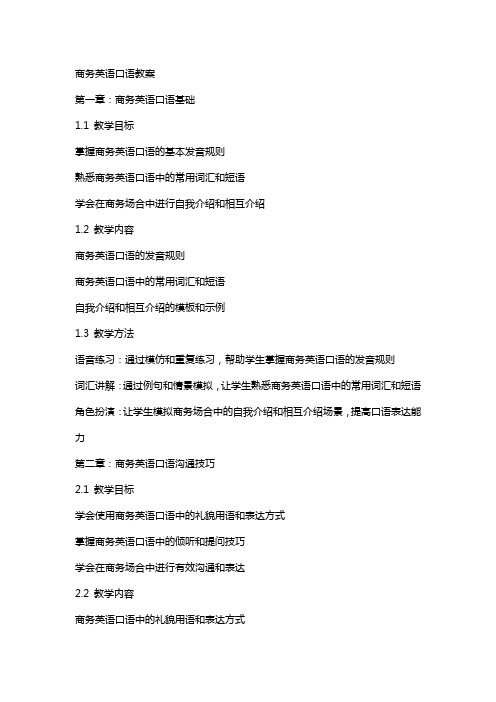
商务英语口语教案第一章:商务英语口语基础1.1 教学目标掌握商务英语口语的基本发音规则熟悉商务英语口语中的常用词汇和短语学会在商务场合中进行自我介绍和相互介绍1.2 教学内容商务英语口语的发音规则商务英语口语中的常用词汇和短语自我介绍和相互介绍的模板和示例1.3 教学方法语音练习:通过模仿和重复练习,帮助学生掌握商务英语口语的发音规则词汇讲解:通过例句和情景模拟,让学生熟悉商务英语口语中的常用词汇和短语角色扮演:让学生模拟商务场合中的自我介绍和相互介绍场景,提高口语表达能力第二章:商务英语口语沟通技巧2.1 教学目标学会使用商务英语口语中的礼貌用语和表达方式掌握商务英语口语中的倾听和提问技巧学会在商务场合中进行有效沟通和表达2.2 教学内容商务英语口语中的礼貌用语和表达方式商务英语口语中的倾听和提问技巧商务英语口语中的有效沟通和表达方式2.3 教学方法情景模拟:通过模拟商务场合中的对话场景,让学生学会使用礼貌用语和表达方式听力练习:通过听力材料和模拟对话,帮助学生掌握倾听和提问技巧小组讨论:让学生分组进行讨论和角色扮演,提高商务英语口语沟通能力第三章:商务英语口语商务礼仪3.1 教学目标了解商务英语口语中的商务礼仪规范学会在商务场合中进行正确的称呼和礼节掌握商务英语口语中的商务礼仪用语和表达方式3.2 教学内容商务英语口语中的商务礼仪规范商务英语口语中的正确称呼和礼节商务英语口语中的商务礼仪用语和表达方式3.3 教学方法案例分析:通过分析商务场合中的案例,让学生了解商务礼仪规范和正确称呼角色扮演:让学生模拟商务场合中的对话场景,练习使用商务礼仪用语和表达方式小组讨论:让学生分组进行讨论和角色扮演,提高商务英语口语商务礼仪能力第四章:商务英语口语商务会议4.1 教学目标学会在商务会议中进行有效的自我介绍和主题介绍掌握商务英语口语中的会议讨论和决策表达方式学会在商务会议中进行有效的商务谈判和沟通协调4.2 教学内容商务英语口语中的自我介绍和主题介绍商务英语口语中的会议讨论和决策表达方式商务英语口语中的商务谈判和沟通协调技巧4.3 教学方法角色扮演:让学生模拟商务会议中的对话场景,练习自我介绍和主题介绍小组讨论:让学生分组进行讨论和角色扮演,提高商务英语口语会议表达和沟通协调能力第五章:商务英语口语商务洽谈5.1 教学目标学会使用商务英语口语中的商务洽谈用语和表达方式掌握商务英语口语中的商务洽谈技巧和策略学会在商务洽谈中进行有效的商务演示和说服对方5.2 教学内容商务英语口语中的商务洽谈用语和表达方式商务英语口语中的商务洽谈技巧和策略商务英语口语中的商务演示和说服技巧5.3 教学方法情景模拟:通过模拟商务洽谈场景,让学生练习使用商务洽谈用语和表达方式演示练习:让学生进行商务演示练习,提高商务英语口语说服能力小组讨论:让学生分组进行讨论和角色扮演,提高商务英语口语商务洽谈能力第六章:商务英语口语商业书信6.1 教学目标掌握商务英语口语中的商业书信常用词汇和表达方式6.2 教学内容商务英语商业书信的基本格式和结构商务英语口语中的商业书信常用词汇和表达方式6.3 教学方法案例分析:通过分析商业书信案例,让学生了解商业书信的基本格式和结构词汇讲解:通过例句和练习,让学生熟悉商务英语口语中的商业书信常用词汇和表达方式第七章:商务英语口语商务电话沟通7.1 教学目标学会使用商务英语口语在电话中进行自我介绍和主题介绍掌握商务英语口语中的电话沟通技巧和策略学会在商务电话沟通中进行有效的信息传递和记录7.2 教学内容商务英语口语中的电话自我介绍和主题介绍商务英语口语中的电话沟通技巧和策略商务英语口语中的电话信息传递和记录技巧7.3 教学方法情景模拟:通过模拟电话沟通场景,让学生练习使用电话自我介绍和主题介绍听力练习:通过听力材料和模拟电话,帮助学生掌握电话沟通技巧和策略小组讨论:让学生分组进行讨论和角色扮演,提高商务英语口语电话沟通能力和信息记录能力第八章:商务英语口语商务宴会8.1 教学目标学会使用商务英语口语在商务宴会中进行自我介绍和相互介绍掌握商务英语口语中的商务宴会礼仪和礼节学会在商务宴会中进行有效的交流和沟通8.2 教学内容商务英语口语中的商务宴会自我介绍和相互介绍商务英语口语中的商务宴会礼仪和礼节商务英语口语中的商务宴会交流和沟通技巧8.3 教学方法角色扮演:让学生模拟商务宴会中的对话场景,练习自我介绍和相互介绍案例分析:通过分析商务宴会礼仪和礼节的案例,让学生了解商务宴会的礼仪规范小组讨论:让学生分组进行讨论和角色扮演,提高商务英语口语商务宴会交流和沟通能力第九章:商务英语口语商务旅行9.1 教学目标学会使用商务英语口语在商务旅行中进行自我介绍和相互介绍掌握商务英语口语中的商务旅行常用词汇和表达方式学会在商务旅行中进行有效的沟通和交流9.2 教学内容商务英语口语中的商务旅行自我介绍和相互介绍商务英语口语中的商务旅行常用词汇和表达方式商务英语口语中的商务旅行沟通和交流技巧9.3 教学方法角色扮演:让学生模拟商务旅行中的对话场景,练习自我介绍和相互介绍词汇讲解:通过例句和练习,让学生熟悉商务英语口语中的商务旅行常用词汇和表达方式小组讨论:让学生分组进行讨论和角色扮演,提高商务英语口语商务旅行沟通和交流能力第十章:商务英语口语商务合同10.1 教学目标学会使用商务英语口语在商务合同中的常用词汇和表达方式掌握商务英语口语中的商务合同阅读和理解技巧学会在商务合同中进行有效的沟通和表达10.2 教学内容商务英语口语中的商务合同常用词汇和表达方式商务英语口语中的商务合同阅读和理解技巧商务英语口语中的商务合同沟通和表达技巧10.3 教学方法词汇讲解:通过例句和练习,让学生熟悉商务英语口语中的商务合同常用词汇和表达方式阅读理解:通过阅读商务合同材料,帮助学生掌握商务合同阅读和理解技巧小组讨论:让学生分组进行讨论和角色扮演,提高商务英语口语商务合同沟通和表达能力重点和难点解析重点环节一:商务英语口语基础掌握商务英语口语的基本发音规则熟悉商务英语口语中的常用词汇和短语学会在商务场合中进行自我介绍和相互介绍重点环节二:商务英语口语沟通技巧学会使用商务英语口语中的礼貌用语和表达方式掌握商务英语口语中的倾听和提问技巧学会在商务场合中进行有效沟通和表达重点环节三:商务英语口语商务礼仪了解商务英语口语中的商务礼仪规范学会在商务场合中进行正确的称呼和礼节掌握商务英语口语中的商务礼仪用语和表达方式重点环节四:商务英语口语商务会议学会在商务会议中进行有效的自我介绍和主题介绍掌握商务英语口语中的会议讨论和决策表达方式学会在商务会议中进行有效的商务谈判和沟通协调重点环节五:商务英语口语商务洽谈学会使用商务英语口语中的商务洽谈用语和表达方式掌握商务英语口语中的商务洽谈技巧和策略学会在商务洽谈中进行有效的商务演示和说服对方重点环节六:商务英语口语商业书信掌握商务英语口语中的商业书信常用词汇和表达方式重点环节七:商务英语口语商务电话沟通学会使用商务英语口语在电话中进行自我介绍和主题介绍掌握商务英语口语中的电话沟通技巧和策略学会在商务电话沟通中进行有效的信息传递和记录重点环节八:商务英语口语商务宴会学会使用商务英语口语在商务宴会中进行自我介绍和相互介绍掌握商务英语口语中的商务宴会礼仪和礼节学会在商务宴会中进行有效的交流和沟通重点环节九:商务英语口语商务旅行学会使用商务英语口语在商务旅行中进行自我介绍和相互介绍掌握商务英语口语中的商务旅行常用词汇和表达方式学会在商务旅行中进行有效的沟通和交流重点环节十:商务英语口语商务合同学会使用商务英语口语在商务合同中的常用词汇和表达方式掌握商务英语口语中的商务合同阅读和理解技巧学会在商务合同中进行有效的沟通和表达本教案围绕商务英语口语的十个重点环节展开教学,涵盖了从基础发音、常用词汇和短语,到商务礼仪、商务会议、商务洽谈、商业书信、商务电话沟通、商务宴会、商务旅行以及商务合同等多个方面。
商务英语教学设计方案
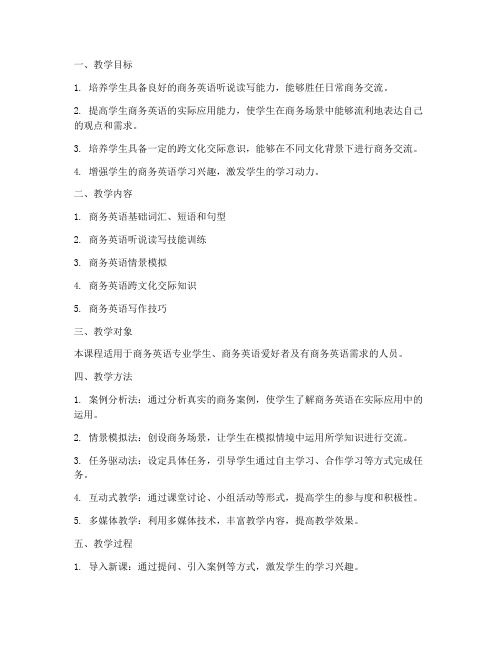
一、教学目标1. 培养学生具备良好的商务英语听说读写能力,能够胜任日常商务交流。
2. 提高学生商务英语的实际应用能力,使学生在商务场景中能够流利地表达自己的观点和需求。
3. 培养学生具备一定的跨文化交际意识,能够在不同文化背景下进行商务交流。
4. 增强学生的商务英语学习兴趣,激发学生的学习动力。
二、教学内容1. 商务英语基础词汇、短语和句型2. 商务英语听说读写技能训练3. 商务英语情景模拟4. 商务英语跨文化交际知识5. 商务英语写作技巧三、教学对象本课程适用于商务英语专业学生、商务英语爱好者及有商务英语需求的人员。
四、教学方法1. 案例分析法:通过分析真实的商务案例,使学生了解商务英语在实际应用中的运用。
2. 情景模拟法:创设商务场景,让学生在模拟情境中运用所学知识进行交流。
3. 任务驱动法:设定具体任务,引导学生通过自主学习、合作学习等方式完成任务。
4. 互动式教学:通过课堂讨论、小组活动等形式,提高学生的参与度和积极性。
5. 多媒体教学:利用多媒体技术,丰富教学内容,提高教学效果。
五、教学过程1. 导入新课:通过提问、引入案例等方式,激发学生的学习兴趣。
2. 新课讲授:讲解商务英语基础词汇、短语和句型,进行听说读写技能训练。
3. 情景模拟:创设商务场景,让学生在模拟情境中运用所学知识进行交流。
4. 跨文化交际知识讲解:介绍不同文化背景下的商务礼仪和沟通技巧。
5. 商务英语写作技巧讲解:指导学生撰写商务信函、报告等应用文。
6. 课堂小结:总结本节课所学内容,布置课后作业。
7. 课后辅导:针对学生在学习过程中遇到的问题进行个别辅导。
六、教学评价1. 平时成绩:占课程总成绩的40%,包括课堂表现、作业完成情况等。
2. 期中考试:占课程总成绩的30%,测试学生的商务英语听说读写能力。
3. 期末考试:占课程总成绩的30%,测试学生的商务英语实际应用能力。
七、教学资源1. 教材:《商务英语》系列教材2. 教学课件3. 网络资源:商务英语学习网站、论坛等4. 商务案例库通过本教学设计方案的实施,相信学生能够在商务英语学习过程中取得显著的进步,为将来的商务工作打下坚实的基础。
商务英语课教案

商务英语课教案一、引言商务英语是指使用英语进行商务活动的语言交流。
在当今全球化的商业环境中,商务英语的重要性日益突显。
为了提高学生的商务英语能力,本文设计了一份商务英语课教案,旨在帮助学生学习并运用商务英语。
二、目标1. 帮助学生了解商务英语的基本概念和应用领域。
2. 培养学生的商务交际能力,包括口语、听力和写作等方面。
3. 培养学生的商务思维和分析能力,以解决实际商务问题。
三、背景知识商务英语是一门专门针对商务活动的英语课程,内容包括商务会议、商务谈判、商务信函等。
学生需要具备一定的英语基础,包括词汇量和语法知识。
四、教学方法1. 情景教学:通过模拟实际的商务场景,帮助学生更好地理解和运用商务英语。
2. 合作学习:鼓励学生通过小组合作学习,共同解决商务问题,提高学习效果。
3. 多媒体教学:利用多媒体资源,如视频、音频等,为学生提供丰富的商务英语学习材料。
五、教学内容1. 商务英语基础知识:包括商务词汇、商务用语、商务惯用语等。
学生需要掌握基本的商务英语词汇和常用表达方式。
2. 商务会议:学习如何组织和参与商务会议,包括会议邀请函的撰写、会议议程的制定等。
3. 商务谈判:学习商务谈判的基本技巧和策略,包括询盘、报价、议价等环节。
4. 商务信函:学习商务信函的写作技巧和格式,包括邀请函、感谢信、投诉信等。
5. 商务演讲:学习如何进行有效的商务演讲,包括演讲技巧、演讲稿的撰写等。
6. 商务文化:学习不同国家和地区的商务文化习俗,了解跨文化沟通中的注意事项。
7. 商务礼仪:学习商务场合的礼仪规范,包括商务社交、商务晚宴等。
8. 商务案例分析:通过分析实际的商务案例,帮助学生理解商务英语的应用场景。
9. 商务法律知识:了解商务活动中的法律法规,避免商务纠纷和法律风险。
10. 商务伦理:学习商务伦理原则和道德规范,提高商务行为的道德意识。
11. 商务沟通技巧:学习有效的商务沟通技巧,如倾听、提问、反馈等。
商务英语高效教案设计模板
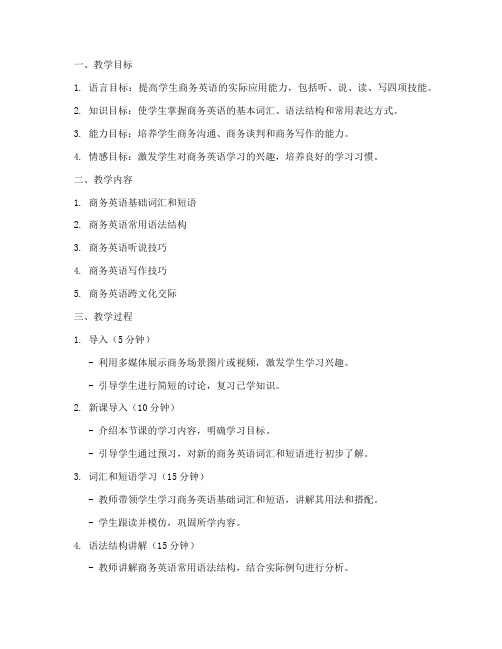
一、教学目标1. 语言目标:提高学生商务英语的实际应用能力,包括听、说、读、写四项技能。
2. 知识目标:使学生掌握商务英语的基本词汇、语法结构和常用表达方式。
3. 能力目标:培养学生商务沟通、商务谈判和商务写作的能力。
4. 情感目标:激发学生对商务英语学习的兴趣,培养良好的学习习惯。
二、教学内容1. 商务英语基础词汇和短语2. 商务英语常用语法结构3. 商务英语听说技巧4. 商务英语写作技巧5. 商务英语跨文化交际三、教学过程1. 导入(5分钟)- 利用多媒体展示商务场景图片或视频,激发学生学习兴趣。
- 引导学生进行简短的讨论,复习已学知识。
2. 新课导入(10分钟)- 介绍本节课的学习内容,明确学习目标。
- 引导学生通过预习,对新的商务英语词汇和短语进行初步了解。
3. 词汇和短语学习(15分钟)- 教师带领学生学习商务英语基础词汇和短语,讲解其用法和搭配。
- 学生跟读并模仿,巩固所学内容。
4. 语法结构讲解(15分钟)- 教师讲解商务英语常用语法结构,结合实际例句进行分析。
- 学生练习相关语法结构,巩固所学知识。
5. 听说技巧训练(20分钟)- 播放商务英语听力材料,让学生进行跟读和复述。
- 教师点评,纠正发音和语法错误。
6. 商务英语写作训练(20分钟)- 教师展示商务英语写作范例,讲解写作技巧。
- 学生根据范例进行写作练习,教师点评并给予修改建议。
7. 跨文化交际讲解(10分钟)- 教师讲解商务英语跨文化交际的注意事项,分析文化差异。
- 学生进行角色扮演,模拟商务场景,提高实际沟通能力。
8. 总结与作业布置(5分钟)- 教师对本节课所学内容进行总结,强调重点和难点。
- 布置课后作业,巩固所学知识。
四、教学评价1. 课堂表现:观察学生在课堂上的参与度、积极性、纪律性。
2. 听力理解:通过听力测试,评估学生对商务英语材料的理解能力。
3. 口语表达:通过口语测试,评估学生运用商务英语进行沟通的能力。
- 1、下载文档前请自行甄别文档内容的完整性,平台不提供额外的编辑、内容补充、找答案等附加服务。
- 2、"仅部分预览"的文档,不可在线预览部分如存在完整性等问题,可反馈申请退款(可完整预览的文档不适用该条件!)。
- 3、如文档侵犯您的权益,请联系客服反馈,我们会尽快为您处理(人工客服工作时间:9:00-18:30)。
NO: 1
湖南涉外经济学院教案(分页)
NO 1 Period 1-2
Step 1. Warm-up.(5 minutes)
Video appreciation &Questions :Alibaba IPO
Step 2. Background information (5 minutes)
1. People study English for different purposes. Thus English falls into two categories: English for General Purposes (EGP) and English for Specific Purpose (ESP). Business English is a part of ESP.It implies the definition of a specific language corpus and emphasis on particular kinds of communication in specific context.
2. IATEFL:International Association of Teachers of English as Foreign Language的缩写,国际英语外语教师协会,成立于1967年,总部设在英语肯特大学,是目前国际上规模最大、最具权威性的英语外语教师学术机构之一,其总之是为在世界范围内沟通、发展、支持英语外语教学。
它在世界100多个国家中拥有3500余名会员。
Step 3. New words and Expressions. (10 minutes)
1.Specific. 特定的
2.Consider 考虑
3.Correspondence 一致,符合
4.Efficient 有效的
5.Electronic电子的
6.Strategic 战略上的
7.Especially 尤其,特别
8.Relate to 与...有关
9.Focus on 集中于
10.Special interest group 特别兴趣小组,特殊利益集团
Step 4. Reading (25 minutes)
1.What is Business English and what is Electronic business?
Business English is English especially related to international trade.It is part of English for specific purposes and can be considered a specialism within English language learning and teaching.Electronic business ,commonly refers to as “E-business”,maybe as the utilization of information and communication technologies in support of all the activities of business.
2.What's the difference between Business English and General English?
General English may encompass the broad vocabulary and varieties of styles found in literature and other general reading and in the world of entertainment and the media.
3.Why do non-native English speakers learn business English ?
Many non-native English speakers learn business English with the goal of doing business with English-speaking countries, or with companies located outside the Anglosphere but which nonetheless use English as a shared language.。
